Hallo Johann, what a fantastic video, very impressive and instructive.
-

Win a Free Custom Engraved Brass Coin!!!
As a way to introduce our brass coins to the community, we will raffle off a free coin during the month of August. Follow link ABOVE for instructions for entering.
-

PRE-ORDER SHIPS IN SCALE TODAY!
The beloved Ships in Scale Magazine is back and charting a new course for 2026!
Discover new skills, new techniques, and new inspirations in every issue.
NOTE THAT OUR FIRST ISSUE WILL BE JAN/FEB 2026
You are using an out of date browser. It may not display this or other websites correctly.
You should upgrade or use an alternative browser.
You should upgrade or use an alternative browser.
La Créole 1827 by archjofo - Scale 1/48 - French corvette
Shortly something slightly off-topic, but related to the Creole:
Today in Naval History - Naval / Maritime Events in History
5 May 1829 – Launch of French Créole, a 24-gun Créole-class corvette of the French Navy
if somebody is interested please take a look:
Today in Naval History - Naval / Maritime Events in History
5 May 1829 – Launch of French Créole, a 24-gun Créole-class corvette of the French Navy
if somebody is interested please take a look:
Naval/Maritime History - 5th of May - Today in Naval History - Naval / Maritime Events in History
Today in Naval History - Naval / Maritime Events in History 4 May 1945 - USS Morrison – On 4 May 1945, in the Battle of Okinawa, the US destroyer was sunk after being hit by four kamikaze aircraft. After the fourth hit the destroyer, heavily damaged, began to list sharply to starboard. Two...
shipsofscale.com
- Joined
- Nov 10, 2019
- Messages
- 469
- Points
- 373

@Steef66
Hi Stehpan,
sorry for the late reply.
Thanks in advance for the kind comment.
The rope around the ring is not woven, I glued the ropes next to each other on a piece of silk according to the thickness of the ring. Then I wrapped this diagonally around the ring..
I am not quite clear whether I have formulated it so understandably. I hope that it can be understood.
Hi Stehpan,
sorry for the late reply.
Thanks in advance for the kind comment.
The rope around the ring is not woven, I glued the ropes next to each other on a piece of silk according to the thickness of the ring. Then I wrapped this diagonally around the ring..
I am not quite clear whether I have formulated it so understandably. I hope that it can be understood.
- Joined
- Aug 8, 2019
- Messages
- 5,522
- Points
- 738

Then you have done a good job, it looks like woven. I did it to like you did and it don't looks like woven. So there is improvement to do for me. Thanks.@Steef66
Hi Stehpan,
sorry for the late reply.
Thanks in advance for the kind comment.
The rope around the ring is not woven, I glued the ropes next to each other on a piece of silk according to the thickness of the ring. Then I wrapped this diagonally around the ring..
I am not quite clear whether I have formulated it so understandably. I hope that it can be understood.
- Joined
- Nov 10, 2019
- Messages
- 469
- Points
- 373

Fixing the topgallant shrouds
A long time ago I dealt with this topic in more detail, but without any concrete result. However, I can no longer postpone the implementation of this detail. According to my research and a corresponding interpretation of the description in the monograph of La Créole, the topgallant shrouds are now fixed by lashings, which are attached to the fittings of the deadeyes. The respective lashing is made with thimbles.
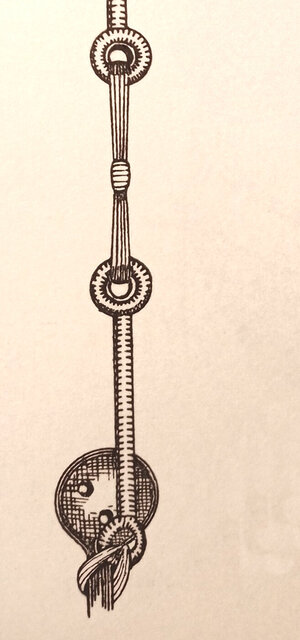
On the next picture I show the course of the topgallant shrouds using the main top as an example.
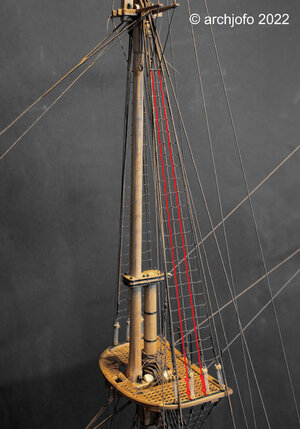
So once again thimbles had to be made, 24 of them in total. In relation to the deadeyes, the thimbles should not be too big, of course. That's why I had to introduce another thimble size (ø 0.9 mm / ø 1.2 mm / ø 2.0 / ø 2.5 mm) in addition to the ones used for this model so far. For this purpose I bought brass tubes with a diameter of 1.0 mm, which finally resulted in thimbles with a diameter of about 1.6 mm.
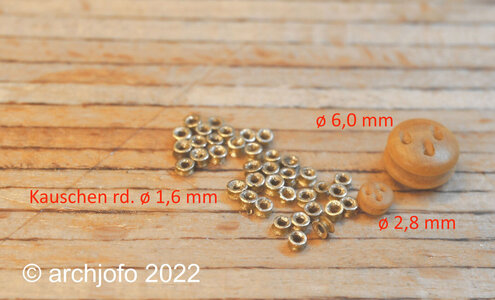
In the meantime I only make the thimbles with a suitable centre punch. With the cone-shaped point I form the tube section into a thimble with lightly dosed hammer strokes, as shown in the following picture.
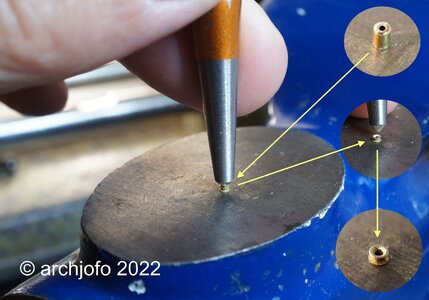
To make the strops for the lower thimbles I use served ropes with ø 0.35 mm. For tying to the fittings of the deadeyes, eyes are formed as shown in the drawing before.
The last picture shows the finished strops, 4 x 3 pieces in total. The shorter strops are for the mizzen mast.
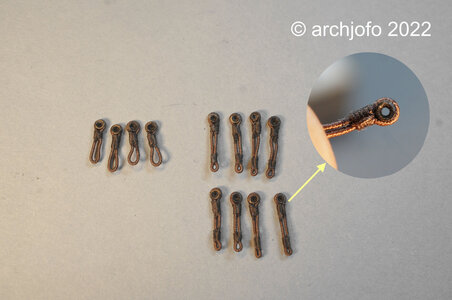
I will report about the fixing of the topgallant shrouds on the model soon.
To be continued ...
A long time ago I dealt with this topic in more detail, but without any concrete result. However, I can no longer postpone the implementation of this detail. According to my research and a corresponding interpretation of the description in the monograph of La Créole, the topgallant shrouds are now fixed by lashings, which are attached to the fittings of the deadeyes. The respective lashing is made with thimbles.

On the next picture I show the course of the topgallant shrouds using the main top as an example.

So once again thimbles had to be made, 24 of them in total. In relation to the deadeyes, the thimbles should not be too big, of course. That's why I had to introduce another thimble size (ø 0.9 mm / ø 1.2 mm / ø 2.0 / ø 2.5 mm) in addition to the ones used for this model so far. For this purpose I bought brass tubes with a diameter of 1.0 mm, which finally resulted in thimbles with a diameter of about 1.6 mm.

In the meantime I only make the thimbles with a suitable centre punch. With the cone-shaped point I form the tube section into a thimble with lightly dosed hammer strokes, as shown in the following picture.

To make the strops for the lower thimbles I use served ropes with ø 0.35 mm. For tying to the fittings of the deadeyes, eyes are formed as shown in the drawing before.
The last picture shows the finished strops, 4 x 3 pieces in total. The shorter strops are for the mizzen mast.

I will report about the fixing of the topgallant shrouds on the model soon.
To be continued ...
- Joined
- Nov 10, 2019
- Messages
- 469
- Points
- 373

@Richie
Thanks for your nice comment.
Continuation: Fixing the topgallant shrouds
In the meantime, all topgallant shrouds have been attached to the corresponding fittings of the deadeyes. The final fixing of the lashings only makes sense after all the shrouds have been installed.
The ropes were fastened with a simple splice.
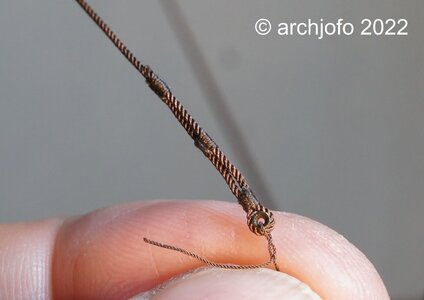
The lashings of the topgallant shrouds are here attached to the foremast behind the 2nd and 3rd top mast shroud.
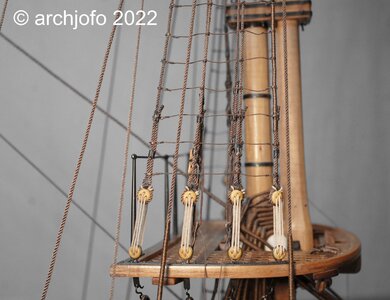
Next I will make the catharpins of the top- and topgallant shrouds.
See you soon ...
Thanks for your nice comment.
Continuation: Fixing the topgallant shrouds
In the meantime, all topgallant shrouds have been attached to the corresponding fittings of the deadeyes. The final fixing of the lashings only makes sense after all the shrouds have been installed.
The ropes were fastened with a simple splice.

The lashings of the topgallant shrouds are here attached to the foremast behind the 2nd and 3rd top mast shroud.

Next I will make the catharpins of the top- and topgallant shrouds.
See you soon ...
- Joined
- Nov 10, 2019
- Messages
- 469
- Points
- 373

Continuation: Catharpins - Trélingage
As already explained some time ago in my construction report LINK, the shrouds of the topmasts and topgallant masts of the La Créole were also equipped with catharpins.
The following picture shows that the catharpin for the topallant shrouds is much smaller compared to the catharpin of the lower shrouds of the mainmast.
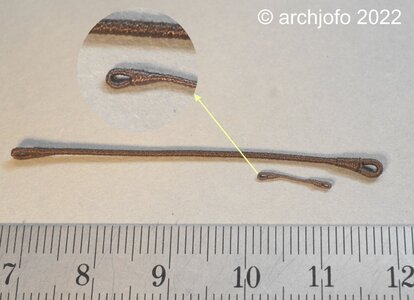
The next picture compares catharpin for the lower shrouds, the topmast shrouds and topgallant shrouds.
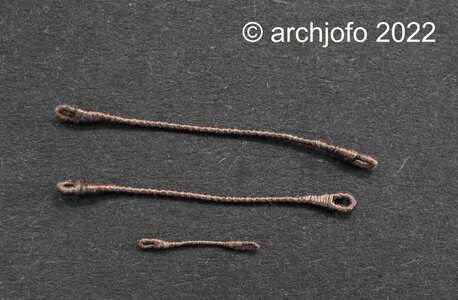
With a length of about 10 mm from a 0.25 mm served rope, the catharpin of the fore topgallant shrouds was then lashed in place.
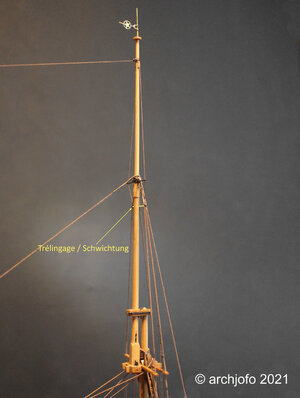
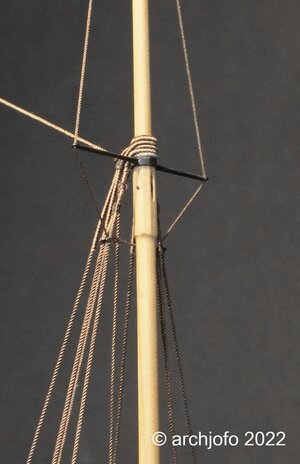
The last pictures show the already lashed catharpins (0.35 mm served ropes) of the topmast shrouds. The comparison shows what happens if the length of the catharpins is not made accurately. When the shrouds are tightened, they give way and move outward. Therefore new catharpins had to be made again.
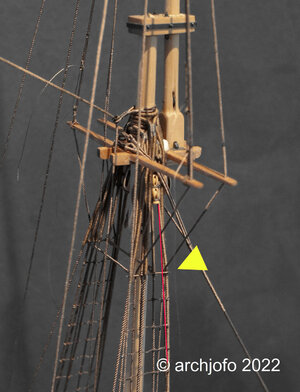
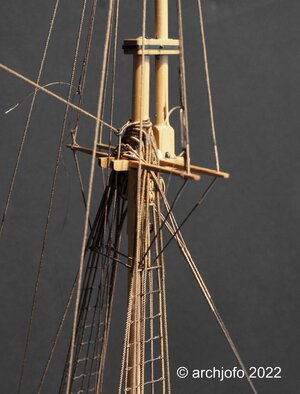
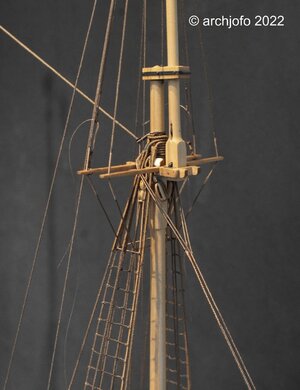
To be continued ...
As already explained some time ago in my construction report LINK, the shrouds of the topmasts and topgallant masts of the La Créole were also equipped with catharpins.
The following picture shows that the catharpin for the topallant shrouds is much smaller compared to the catharpin of the lower shrouds of the mainmast.

The next picture compares catharpin for the lower shrouds, the topmast shrouds and topgallant shrouds.

With a length of about 10 mm from a 0.25 mm served rope, the catharpin of the fore topgallant shrouds was then lashed in place.


The last pictures show the already lashed catharpins (0.35 mm served ropes) of the topmast shrouds. The comparison shows what happens if the length of the catharpins is not made accurately. When the shrouds are tightened, they give way and move outward. Therefore new catharpins had to be made again.



To be continued ...
just amazing - Ich ziehe meinen Hut vor deiner Arbeit
Hello Johann,
I really need to get rid of something now. I am always amazed by your posts, your fantastic work. A little info for everyone here in the forum, as Johann wrote at the beginning of his report, I am also still on the road in other forums, including the German forum
( https://www.segelschiffsmodellbau.com/ ).
In the last DAYS, I've read 291 pages of a really great diary. I think @Uwek once mentioned you should write a book and I'm not sure anymore, but you said you didn't have time for that. Your construction diary in the German forum has been going for over 10 years now and in my opinion that is already your book. It doesn't matter whether it's your brass work that you present in great pictures, or carvings, building cannons, braces, etc.
The amazing thing about it is your step-by-step explanations in text and pictures. Added to this is the research you have done and are still doing, and you always have a great explanation for questions.
One picture in particular burned into my mind, your notebook with the drawings of the number of pieces and the dimensions, that's really amazing. I've taken the liberty of including it as an attachment. I very much regret not having met you personally in Augsburg, but I am sure that I will someday. Hats off in the deepest reverence to your achievements.
Greetings Tobias.
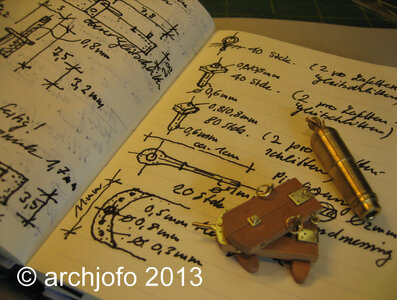
The picture conveys to me that you stand with a love for your work.
I really need to get rid of something now. I am always amazed by your posts, your fantastic work. A little info for everyone here in the forum, as Johann wrote at the beginning of his report, I am also still on the road in other forums, including the German forum
( https://www.segelschiffsmodellbau.com/ ).
In the last DAYS, I've read 291 pages of a really great diary. I think @Uwek once mentioned you should write a book and I'm not sure anymore, but you said you didn't have time for that. Your construction diary in the German forum has been going for over 10 years now and in my opinion that is already your book. It doesn't matter whether it's your brass work that you present in great pictures, or carvings, building cannons, braces, etc.
The amazing thing about it is your step-by-step explanations in text and pictures. Added to this is the research you have done and are still doing, and you always have a great explanation for questions.
One picture in particular burned into my mind, your notebook with the drawings of the number of pieces and the dimensions, that's really amazing. I've taken the liberty of including it as an attachment. I very much regret not having met you personally in Augsburg, but I am sure that I will someday. Hats off in the deepest reverence to your achievements.
Greetings Tobias.

The picture conveys to me that you stand with a love for your work.
- Joined
- Nov 10, 2019
- Messages
- 469
- Points
- 373

@Tobias
Hello Tobias,
what you write about my construction report makes me blush with shame. Thank you very much for that, that is a lot of praise.
One knows with many actually only the nickname, and can thus assign the person with difficulty.
So we probably walked past each other in Augsburg, without talking to each other. I am also sorry for that. Next time we should wear signs with the nicknames.
Hello Tobias,
what you write about my construction report makes me blush with shame. Thank you very much for that, that is a lot of praise.
One knows with many actually only the nickname, and can thus assign the person with difficulty.
So we probably walked past each other in Augsburg, without talking to each other. I am also sorry for that. Next time we should wear signs with the nicknames.
- Joined
- Apr 20, 2020
- Messages
- 6,205
- Points
- 738

Dear Johann@Tobias
Hello Tobias,
what you write about my construction report makes me blush with shame. Thank you very much for that, that is a lot of praise.
One knows with many actually only the nickname, and can thus assign the person with difficulty.
So we probably walked past each other in Augsburg, without talking to each other. I am also sorry for that. Next time we should wear signs with the nicknames.
First I would like to join the compliments of all the members on the high quality of your work and the detailed explanations on your special creative methods.


I'm saying this also from reading the building log of Korvette "La Créole" 1827 on a website in German and I am only on page 13 of 291.
It seems to me that I also missed you at the friends meeting in Augsburg and for that I am really sorry.
- Joined
- Nov 10, 2019
- Messages
- 469
- Points
- 373

@shota70
Hello ,
thank you very much for your appreciation of my work. I recognize your interest from the many of your LIKES. Thank you for that too.
Apparently we missed each other in Augsburg too, sorry.
There were beautiful models to see and I had many interesting conversations. But the time was just too short.
Hello ,
thank you very much for your appreciation of my work. I recognize your interest from the many of your LIKES. Thank you for that too.
Apparently we missed each other in Augsburg too, sorry.
There were beautiful models to see and I had many interesting conversations. But the time was just too short.
- Joined
- Nov 10, 2019
- Messages
- 469
- Points
- 373

Standing rigging for jib and flying jib boom - Bâton de foc et bâton de clinfoc
To complete the standing rigging (fore topmast stay and fore topgallant stay) for my French corvette, it finally became necessary to attach the jib and outer jib boom. Since these are very delicate and therefore very sensitive parts of the model, I delayed their assembly as long as possible. One or the other ship modeler might have already made the painful experience that a small carelessness leads to the breakage of these booms.
Before the realization, extensive research was done on the required detail elements. The information in the monograph on La Créole by J. Boudriot is not sufficient for this. In addition, some points concerning the guidance of the rigging (mooring in the forecastle), the dolphin striker (angular position) and the flying jib boom (length and attachment) had to be clarified.
I tried to record the compiled results in my new sketchbook (the old one is already full), as can be seen below:
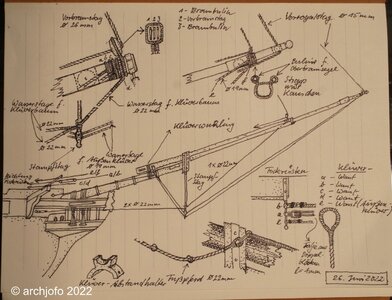
After more intensive occupation with this topic, I have only realized what a wealth of detail it contains. However, a few open questions still remain, such as whether foot ropes were also attached to the flying jib boom and whether they were single or double.
On the next picture you can already see some rigging elements with jib and flying jib boom. Besides the spacer and the triple block, the travelers are also shown. The so-called jib inhaulers are later guided over the single blocks attached to them. It should be mentioned that these are the smallest blocks of the model I have made so far, with a length of 2.8 mm.
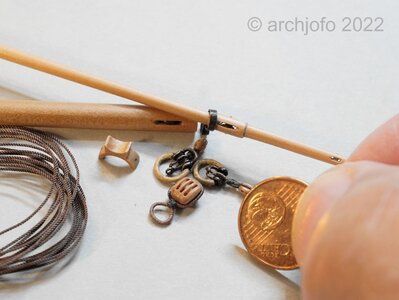
After making the necessary ropes, I will soon be able to start rigging the jib boom step by step, but more about that soon.
To be continued ...
To complete the standing rigging (fore topmast stay and fore topgallant stay) for my French corvette, it finally became necessary to attach the jib and outer jib boom. Since these are very delicate and therefore very sensitive parts of the model, I delayed their assembly as long as possible. One or the other ship modeler might have already made the painful experience that a small carelessness leads to the breakage of these booms.
Before the realization, extensive research was done on the required detail elements. The information in the monograph on La Créole by J. Boudriot is not sufficient for this. In addition, some points concerning the guidance of the rigging (mooring in the forecastle), the dolphin striker (angular position) and the flying jib boom (length and attachment) had to be clarified.
I tried to record the compiled results in my new sketchbook (the old one is already full), as can be seen below:

After more intensive occupation with this topic, I have only realized what a wealth of detail it contains. However, a few open questions still remain, such as whether foot ropes were also attached to the flying jib boom and whether they were single or double.
On the next picture you can already see some rigging elements with jib and flying jib boom. Besides the spacer and the triple block, the travelers are also shown. The so-called jib inhaulers are later guided over the single blocks attached to them. It should be mentioned that these are the smallest blocks of the model I have made so far, with a length of 2.8 mm.

After making the necessary ropes, I will soon be able to start rigging the jib boom step by step, but more about that soon.
To be continued ...
Bourjo
Un grand bravo pour cette réalisation et aussi pour vos photos, c'est un plaisir de suivre cette réalisation ! bonne continuation
Bourjo
Congratulations for this achievement and also for your photos, it is a pleasure to follow this achievement! best wishes
Un grand bravo pour cette réalisation et aussi pour vos photos, c'est un plaisir de suivre cette réalisation ! bonne continuation
Bourjo
Congratulations for this achievement and also for your photos, it is a pleasure to follow this achievement! best wishes
Last edited by a moderator:
Excellent research and once again a great realization. Excellent as always, Johann
Sorry to write it in these words:
"Wie geil ist das denn?......."
In the meantime we are used to the highest quality of your rigging works. This time I mean your "sketchbook"
your sketches have the same quality like your real work - WOW
Maybe you should get into contact with Didier Berti from ancre. I could imagine, that a book like our friend and member @Francis Jonet published once
later on ancre published also an english version translated by our friend and member @Gilles Korent
"Wie geil ist das denn?......."
In the meantime we are used to the highest quality of your rigging works. This time I mean your "sketchbook"
your sketches have the same quality like your real work - WOW
Maybe you should get into contact with Didier Berti from ancre. I could imagine, that a book like our friend and member @Francis Jonet published once
Book review - Accastillage et gréement du modèle réduit d'un vaisseau de 74 canons" By Francis Jonet
Book Review: Accastillage et gréement du modèle réduit d'un vaisseau de 74 canons by Francis Jonet translated something like: Fitting and rigging a 74-gun model ship today I want to show you a great additional source, which was prepared on a private basis by my french modeling friend...
shipsofscale.com
later on ancre published also an english version translated by our friend and member @Gilles Korent
Book review - "Fitting and rigging a 74-gun model ship" by Francis Jonet
Book Review: Fitting and rigging a 74-gun model ship Author: Francis Jonet, our member @Francis Jonet translated into English by Gille Korent, our member @Gilles Korent The front and back side of the Book This guide is a help to the construction of the equipment of a ship model of the...
shipsofscale.com





